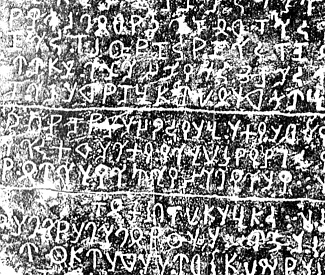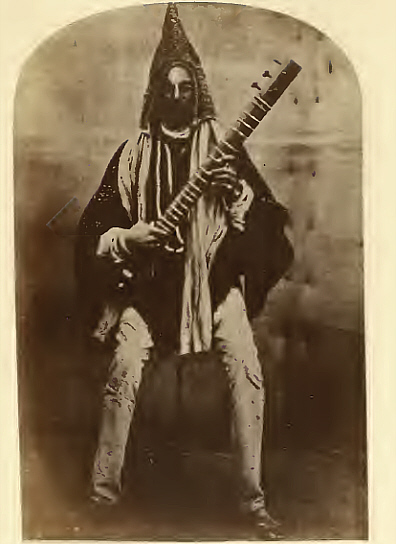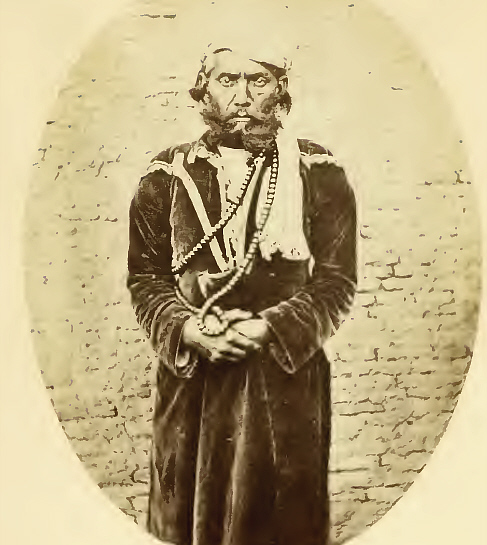

Zitierweise / cite as:
Bhāt / India Museum (1868). -- (Quellenkunde zur indischen Geschichte bis 1858 / Alois Payer ; 10. Mündliche Quellen, 2.). -- Fassung vom 2008-06-09. -- http://www.payer.de/quellenkunde/quellen102.htm
Erstmals publiziert als:
The people of India : a series of photographic illustrations, with descriptive letterpress, of the races and tribes of Hindustan, originally prepared under the authority of the government of India, and reproduced by order of the Secretary of State for India in Council / edited by J. Forbes Watson [1827 - 1892] and John William Kaye [1814 - 1876]. -- London : India Museum, 1868-1875. -- ( Bde. : Ill. ; 32 cm. -- In v. 1-3 the letterpress is by various authors; in v. 4-8, by Meadows Taylor [1808 - 1876]. -- Bd. 2. -- 1868. -- Nr. 91; 109. -- Online: http://www.archive.org/details/peopleofindiaser02greauoft. -- Zugriff am 2008-06-09. -- "Not in copyright."
Erstmals hier veröffentlicht: 2008-06-09
Überarbeitungen:
Anlass: Lehrveranstaltung FS 2008
©opyright: Public domain
Dieser Text ist Teil der Abteilung Sanskrit von Tüpfli's Global Village Library
Falls Sie die diakritischen Zeichen nicht dargestellt bekommen, installieren Sie eine Schrift mit Diakritika wie z.B. Tahoma.

BHAT. WANDERING MINSTREL. BENARES.
BHAT. (91)
BHAT, also Bliarat and Bhattu, is the Hindoo equivalent for bard, herald, genealogist, and chronicler. In former days he was the son of a Kshatriya father and Vaisya mother ; but the modem Bhat is sometimes said to have been born of a Brahmin widow by a Kshatriya father. He is to be found all over India, and fulfils the same office as his prototype, but with inferior dignity, although in Western India, where he is identified with the Charun, his personal security is held sufficient for the payment of a debt or the fulfilment of an engagement, its violation being followed by the voluntary death, either of the Bhat himself or of some member of his family, the retribution of which falls on the defaulter. In some parts of India Bhats are distinguished as Birru-bhat and Jaga-bhat ; the former being lined on special occasions to recite the traditions and sing the praises of the family; while the latter are family chroniclers by hereditary descent, and visit the members periodically to take note of all occurrences regarding them.
The Bhats are respected for then reputed sanctity, but equally dreaded for their rapacity. It is indeed noteworthy that when measures were adopted to abolish female infanticide among the Rajpoots of the North-Western Provinces —one of the main inducements to the crime being the enormous expense of weddings—the issue of an order to the police to prevent Bhats forcing themselves on wedding parties and extorting money, under threat of a curse, from the master of the wedding feast, was one of the first steps taken.
In some parts of India the Bhats form village communities. Some have become converts to Islam, but this is rare. The village Bhat is a person of wholly inferior class.
Among all classes and tribes in which the crime of dacoity is followed as an hereditary profession, there is none whose proceedings are characterised by such boldness and skill as the Bhats. The Bhat dacoits claim to be of the same descent as the Bard Bhats, and imitate then calling, but in an inferior degree of perfection, and "Improvisatori" are seldom found among them, though they are competent reciters. Among this class, however, recitation is but a cloak for their hereditary profession ; and it is to that their whole energies and intelligence used to be devoted until the operations against them of the Department of Thuggee and Dacoity, which has rendered such eminent service to the people of India in the discovery and suppression of hitherto concealed and unknown crime. The dacoities of the Bhats were always directed against the houses of wealthy sahonkars or bankers, and their mode of proceeding was thus. The Bhats had no settled habitations ; they carried small tents of goat's hair cloth about with them, and travelled from place to place as singers and reciters of plays and genealogical legends and histories. In these journeys they could discern where the leading bankers or money dealers of the district resided, and the most intelligent members of the gang were sent to gain a knowledge of the locality. This having been effected, and the treasure room in the banker's house ascertained, the gang assembled at a place fifty or a hundred miles distant, and met at a rendezvous near the place to be attacked, on a certain day decided according to astrology or lucky omens. The attack took place at twilight, as an invariable custom. It is at that hour that people are returning to villages, and bodies of men are hardly remarked. The persons who carry the sacred axe or axes, are told off to the most important duty. The torch bearers are next, and the rest armed with spears, assist the axe bearers or guard the approaches to the house. Stations are taken up immediately by the watchmen, who place the spear-heads on the bamboos they carry. The axe-men put the helves unto the axe-heads, which are very heavy and faced with steel ; with these they break in doors or hew padlocks from chests or cupboards, and the treasure found is secured. Any one who opposes is struck down by the axe or speared ; and the whole operation is so sudden and so violent, that many instances are on record of large amounts of plunder in coin and valuables being carried off by gangs without any alarm in the town or village until it was too late for pursuit. Once out of the town or village where the crime was committed, the Bhats mounted their hardy ponies which had been concealed, and rode till morning, perhaps fifty miles, reaching their camp the second day. They had left no trace, and there was no clue to their detection. Hundreds of such cases are detailed by the approvers, and the adventures of Kankia Jemadar, or Bhow, are as full of romance as those of the most celebrated Thugs, The Bhats do not, however, commit indiscriminate or predetermined murder ; it is only during opposition that any one is stricken down, and as they would say, in fair fight and with steel, not like the Thugs, by treachery and deceit. The Bhats and their allies or connexions the Sanseas or Sausseas of Hindostan are, however, nearly extinct as dacoits, and all their famous leaders, have, like those of the Thugs, been apprehended, tried and hanged, or transported, or have become approvers ; few notorious or experienced Bhat dacoits are now at large.

BHAT. WANDERING MINSTREL. MAHOMEDAN. MORADABAD.
BHĀT.—MUSSULMAN. (109)
BHĀTS, as has been already observed under head of No. 91, are to be met with throughout India, especially in the North-West and Western provinces. They are importunate beggars, and, like such people elsewhere, are for the most part an idle, worthless set ; subsisting upon doles at festivals and the general charity of the rich. There are not many of them in the Moradabad [مراداباد ,मुरादाबाद] district. The specimen photographed comes from Umroha, a town in Moradabad full of old and decayed Mahomedan families. The occupation of the Bhāt shown in this photograph is the narration of family traditions and legends, and remarkable historical and other local events, many of which are very curious and interesting. The Bhāts may be considered as much the hereditary depositaries and professors of this knowledge as the ancient Bards were in Britain. The offices of both correspond exactly. The Bhāt is well paid and fed for his work. Umroha was a town which, like many other places where Mahomedans preponderate, behaved infamously in the rebellion.
The height of the individual represented is five feet five inches ; his age, forty-eight years; colour of eyes, grey; and his beard is dyed bright red. He wears a puce-coloured cotton-velvet dress bound with green ; with a mala, or long necklace of beads, round his neck.
Zu: 11. Griechische und lateinische Quellen